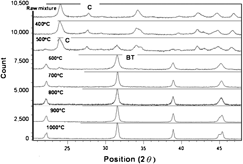Crossref Citations
This article has been cited by the following publications. This list is generated based on data provided by
Crossref.
Lee, Ting‐Tai
Huang, Chi‐Yuen
Chang, Che‐Yuan
Cheng, I‐Kuan
Hu, Ching‐Li
Su, Che‐Yi
Lee, Chun‐Te
and
Fujimoto, Masayuki
2013.
Phase Evolution of Solid‐State BaTiO3 Powder Prepared by Different Starting BaCO3.
International Journal of Applied Ceramic Technology,
Vol. 10,
Issue. s1,
Matsumoto, Hiroaki
Kakibayashi, Hiroshi
Taniguchi, Yoshihumi
Cheng, I‐Kuan
Lee, Ting‐Tai
Hu, Ching‐Li
Lee, Chun‐Te
Fujimoto, Masayuki
and
Rainforth, M.
2013.
Characterization of Solid‐State Reaction of Barium Carbonate and Titanium Dioxide by Spatially Resolved Electron Energy Loss Spectroscopy.
Journal of the American Ceramic Society,
Vol. 96,
Issue. 8,
p.
2651.
Chi, Wenwei
Zhou, Dali
Xia, Yi
Zhou, Jiabei
and
Sun, Si
2015.
Preparation of Ultrafine Barium Titanate under Wet Chemical Mixing Method with TiOSO4. Sintering Performance and Dielectric Properties.
International Journal of Electrochemical Science,
Vol. 10,
Issue. 7,
p.
5327.
Yang, X.
Li, D.
Ren, Z. H.
Zeng, R. G.
Gong, S. Y.
Zhou, D. K.
Tian, H.
Li, J. X.
Xu, G.
Shen, Z. J.
and
Han, G. R.
2016.
Colossal dielectric performance of pure barium titanate ceramics consolidated by spark plasma sintering.
RSC Advances,
Vol. 6,
Issue. 79,
p.
75422.
Vyas, Manoj Kumar
and
Chandra, Amita
2019.
Synergistic effect of conducting and insulating fillers in polymer nanocomposite films for attenuation of X-band.
Journal of Materials Science,
Vol. 54,
Issue. 2,
p.
1304.
Ding, Houyuan
Lin, Liangliang
Gu, Dan
and
Shang, Shaoming
2020.
Synthesis and surface modification of submicron BaTiO3 powders via a facile surfactant-assisted method.
Ceramics International,
Vol. 46,
Issue. 14,
p.
22040.
Ziedan Khalf, Abdulkarim
2021.
Advanced Ceramic Materials.
Khanal, Gopal P.
Fujii, Ichiro
Ueno, Shintaro
and
Wada, Satoshi
2021.
Phase evolution and <110>‐orientation mechanism in RTGG‐processed BaTiO3 ceramics with electrical properties.
Journal of the American Ceramic Society,
Vol. 104,
Issue. 9,
p.
4649.
Jin, Seung Hyun
Lee, Hae Won
Kim, Na Won
Lee, Byung-Woo
Lee, Gil-Geun
Hong, Youn-Woo
Nam, Woo Hyun
and
Lim, Young Soo
2021.
Sonochemically activated solid-state synthesis of BaTiO3 powders.
Journal of the European Ceramic Society,
Vol. 41,
Issue. 9,
p.
4826.
Ji, Myeongjun
Kim, Jeong Hyun
Ryu, Cheol-Hui
and
Lee, Young-In
2022.
Synthesis of self-modified black BaTiO3−x nanoparticles and effect of oxygen vacancy for the expansion of piezocatalytic application.
Nano Energy,
Vol. 95,
Issue. ,
p.
106993.
Lee, Hae Won
Kim, Na Won
Nam, Woo Hyun
and
Lim, Young Soo
2022.
Sonochemical activation in aqueous medium for solid-state synthesis of BaTiO3 powders.
Ultrasonics Sonochemistry,
Vol. 82,
Issue. ,
p.
105874.
Pang, Xiaoxiao
Wang, Tingting
Liu, Bin
Fan, Xiayue
Liu, Xiaorui
Shen, Jing
Zhong, Cheng
and
Hu, Wenbin
2023.
Effect of solvents on the morphology and structure of barium titanate synthesized by a one-step hydrothermal method.
International Journal of Minerals, Metallurgy and Materials,
Vol. 30,
Issue. 7,
p.
1407.
Luan, Saiwei
Wang, Pengfei
Zhang, Lei
He, Yanmei
Huang, Xiong
Jian, Gang
Liu, Cuicui
Yu, Shuhui
Sun, Rong
Cao, Xiuhua
and
Fu, Zhenxiao
2023.
Atmospherically hydrothermal assisted solid-state reaction synthesis of ultrafine BaTiO3 powder with high tetragonality.
Journal of Electroceramics,
Vol. 50,
Issue. 4,
p.
97.
Shangguan, Mingnan
Zhang, Xiuyun
Wang, Chaoying
Zhao, Yunyun
Zhu, Guisheng
Liu, Laijun
and
Xu, Huarui
2023.
Synthesis and performance of tetragonal BaTiO3 fine powders via a facile tartaric acid assisted method.
Journal of the European Ceramic Society,
Vol. 43,
Issue. 15,
p.
6883.
Bouchal, Wissam
Djani, Faiçal
Eddine Mazouzi, Djamel
Tiri, Rima Nour Elhouda
Makhloufi, Soufiane
Laiadi, Chaker
Martínez-Arias, Arturo
Aygün, Ayşenur
and
Sen, Fatih
2024.
Bi-doped BaBiO3 (x = 0%, 5%, 10%, 15%, and 20%) perovskite oxides by a sol–gel method: comprehensive biological assessment and RhB photodegradation.
RSC Advances,
Vol. 14,
Issue. 11,
p.
7359.



